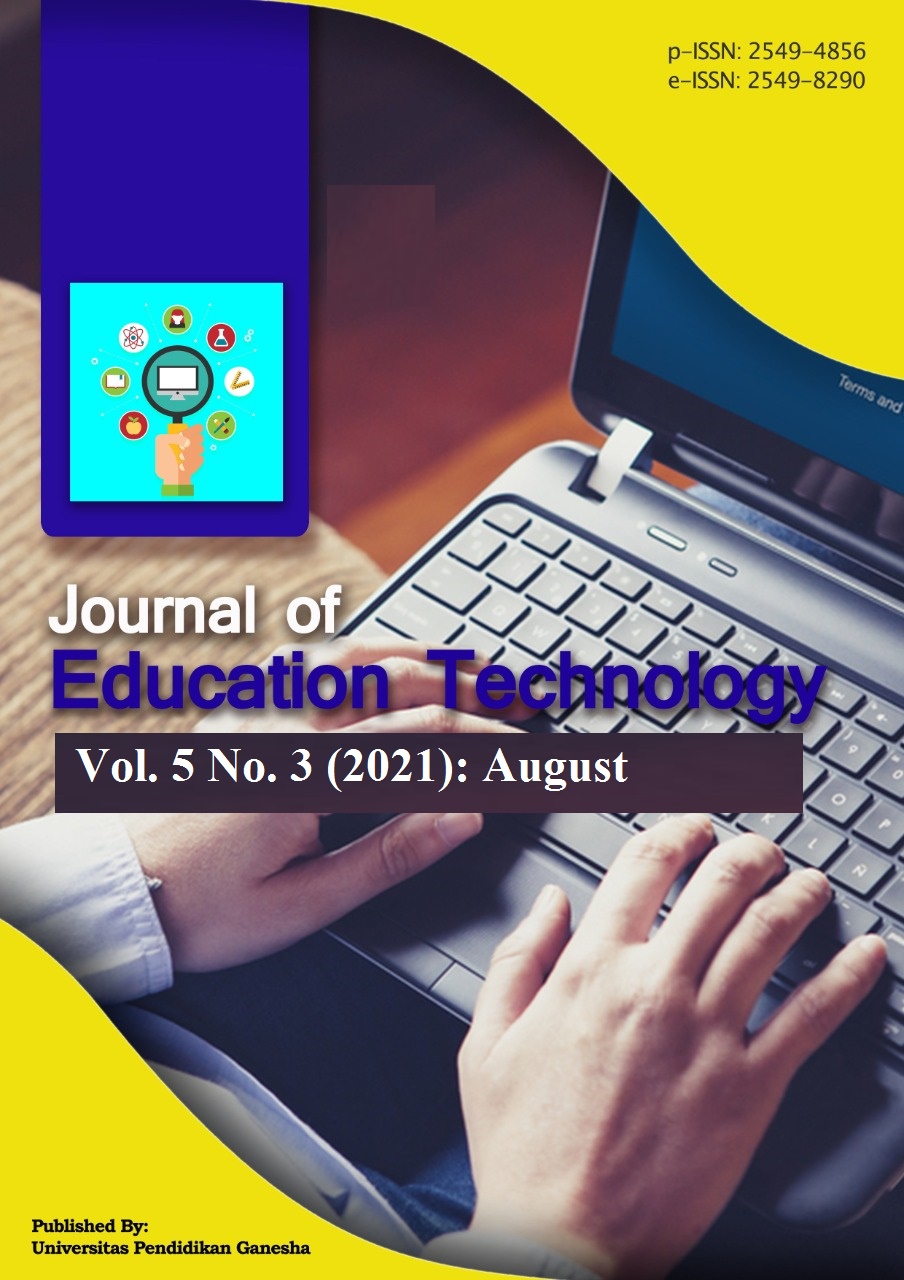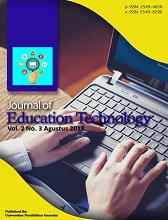Mathematical Disposition of Students in Open-Ended Learning Based on Ethnomathematics
DOI:
https://doi.org/10.23887/jet.v5i3.33535Keywords:
Mathematical Disposition, Open-Ended, EthnomathematicalAbstract
Students' low disposition in mathematics causes students to view mathematics as difficult to understand, thus affecting mathematics learning outcomes. Not many students are active because they lack self-confidence, interest in learning mathematics, and curiosity about mathematics. This has an impact on low mathematics learning outcomes. This study aims to test the increase in the mathematical disposition of students who take part in open-ended learning based on ethnomathematics and determine the effect of mathematical disposition on students' mathematical abilities. This quantitative study refers to a one-group pretest-posttest design. Data collection techniques in this study used non-test and test techniques. The instruments used are questionnaires to measure students' mathematical dispositions and test questions to measure students' mathematical abilities. Data analysis techniques used are gain test and regression analysis. The results study indicates that the mathematical disposition of students who participate in open-ended learning based on ethnomathematics increased by 47%, which means that they are in the medium category and mathematical dispositions affect students' mathematical abilities through the application of open-ended questions learning based on ethnomathematics by 57.9%. It is concluded that ethnomathematics-based open-ended learning can improve students' mathematical disposition. This research is that teachers can use open-ended learning based on ethnomathematics to improve students' mathematical dispositions.
References
Alman. (2017). The Influence of Open-Ended and STAD Method on the Mathematical Problem-Solving Skills in Terms of Learning Achievement. Jurnal Prima Edukasia, 5(2), 112–124. https://doi.org/10.21831/jpe.v5i2.14280.
Areepattamannil, S., Abdelfattah, F., Mahasneh, R. A., Khine, M. S., Welch, A. G., & Melkonian, M. (2016). International Note: Prediction of Mathematics Work Ethic and Performance from Behavioral, Normative, and Control Beliefs among Qatari Adolescents. Journal of Adolescence, 14. https://doi.org/10.1016/j.adolescence.2015.10.016.
Areepattamannil, S., Melkonian, M., & Khine, M. S. (2015). International Note: Exploring Differences in Native and Immigrant Adolescents’ Mathematics Achievement and Dispositions towards Mathematics In Qatar. Journal of Adolescence, 40. https://doi.org/10.1016/j.adolescence.2014.12.010.
Ayyildiz, P., & Yilmaz, A. (2021). ‘Moving the Kaleidoscope’ to See the Effect of Creative Personality Traits on Creative Thinking Dispositions of Preservice Teachers: The Mediating Effect of Creative Learning Environments and Teachers’ Creativity Fostering Behavior. Thinking Skills and Creativity, 41. https://doi.org/10.1016/j.tsc.2021.100879.
Balan, L., Yuen, T., & Mehrtash, M. (2019). Problem-Based Learning Strategy for CAD Software Using Free-Choice and Open-Ended Group Projects. Procedia Manufacturing, 32, 339–347. https://doi.org/10.1016/j.promfg.2019.02.223.
Bayles, J., Peterson, A. D., Pitts, S. J., Bian, H., Burkholder, S., Hegde, A. V., & Stage, V. C. (2021). Food-Based Science, Technology, Engineering, Arts, and Mathematics (STEAM) Learning Activities May Reduce Decline in Preschoolers’ Skin Carotenoid Status. Journal of Nutrition Education and Behavior, 53(4). https://doi.org/10.1016/j.jneb.2020.10.017.
Becerra, J. A., Romero, A., Bellas, F., & Duro, R. J. (2021). Motivational Engine and Long-Term Memory Coupling Within a Cognitive Architecture for Lifelong Open-Ended Learning. Neurocomputing, 452. https://doi.org/10.1016/j.neucom.2019.10.124.
Bicer, A., Marquez, A., Colindres, K. V. M., Schanke, A. A., & Castellon, L. B. (2021). Investigating Creativity-Directed Tasks in Middle School Mathematics Curricula. Thinking Skills and Creativity, 40. https://doi.org/10.1016/j.tsc.2021.100823.
Capraro, M. M., Song, Tingting, Rangel-Chavez, A. F., & Harbaugh, A. (2012). An Investigation of Preservice Teachers’ Use of Guess and Check in Solving a Semi Open-Ended Mathematics Problem. The Journal of Mathematical Behavior, 31(1). https://doi.org/10.1016/j.jmathb.2011.10.002.
Cimen, O. A. (2014). Discussing Ethnomathematics: Is Mathematics Culturally Dependent? Procedia - Social and Behavioral Sciences, 152. https://doi.org/10.1016/j.sbspro.2014.09.215.
Crollen, V., Noël, M.-P., Honoré, N., Degroote, V., & Collignon, O. (2020). Investigating the Respective Contribution of Sensory Modalities and Spatial Disposition in Numerical Training. Journal of Experimental Child Psychology, 190. https://doi.org/10.1016/j.jecp.2019.104729.
Demitra, & Sarjoko. (2018). Effects of Handep Cooperative Learning Based on Indigenous Knowledge on Mathematical Problem Solving Skill. International Journal of Instruction, 11(2), 103–114. https://doi.org/10.12973/iji.2018.1128a.
Fatah, A., Suryadi, D., Sabandar, J., & Turmudi. (2016). Open-Ended Approach: An Effort in Cultivating Students’ Mathematical Creative Thinking Ability and Self-Esteem in Mathematics. Journal on Mathematics Education, 7(1), 9–18. https://doi.org/10.22342/jme.7.1.2813.9-18.
Fathollahzadeh, K., Mardaneh, E., Cigla, M., & Asad, M. W. A. (2021). A Mathematical Model for Open Pit Mine Production Scheduling with Grade Engineering® and Stockpiling. International Journal of Mining Science and Technology, 31(4). https://doi.org/10.1016/j.ijmst.2021.03.011.
Hafidzah, N. A., Azis, Z., & Irvan, I. (2019). The Effect of Open Ended Approach on Problem Solving Ability and Learning Independence in Students’ Mathematics Lessons. Indonesia Journal of Education & Mathematics Science, 1(2), 105–110. https://doi.org/10.30596%2Fijems.v2i1.6176.
Hamid, R., Baharom, S., Taha, M. R., & Kadaruddin, L. K. (2013). Competition as an Innovative Student-centered Learning Method for Open-ended Laboratory Work. Procedia - Social and Behavioral Sciences, 10. https://doi.org/10.1016/j.sbspro.2013.10.726.
Jiang, Y., Clarke-Midura, J., Keller, B., Baker, R. S., Paquette, L., & Ocumpaugh, J. (2018). Note-Taking and Science Inquiry in an Open-Ended Learning Environment. Contemporary Educational Psychology, 55. https://doi.org/10.1016/j.cedpsych.2018.08.004.
Kaufhold, J. P., Tsai, P. S., Blinder, P., & Kleinfeld, D. (2012). Vectorization of Optically Sectioned Brain Microvasculature: Learning Aids Completion of Vascular Graphs by Connecting Gaps and Deleting Open-Ended Segments. Medical Image Analysis, 16(6). https://doi.org/10.1016/j.media.2012.06.004.
Kezer, F., & Turker, B. (2012). Comparison of the Critical Thinking Dispositions of (Studying in the Secondary Science and Mathematics Division) Preservice Teachers. Procedia - Social and Behavioral Sciences, 46. https://doi.org/10.1016/j.sbspro.2012.05.288.
Li, J., Zhao, M., Dai, C., Wang, Z., & Pecht, M. (2021). A Mathematical Method for Open-Circuit Potential Curve Acquisition for Lithium-Ion Batteries. Journal of Electroanalytical Chemistry, 895. https://doi.org/10.1016/j.jelechem.2021.115488.
Mahmoud, A., Hashim, S. S., & Sunarso, J. (2020). Learning Permeability and Fluidisation Concepts Via Open-Ended Laboratory Experiments. Education for Chemical Engineers, 32. https://doi.org//10.1016/j.ece.2020.05.008.
Mourtgos, S. M., & Adams, I. T. (2019). The Rhetoric of De-Policing: Evaluating Open-Ended Survey Responses from Police Officers with Machine Learning-Based Structural Topic Modeling. Journal of Criminal Justice, 64. https://doi.org/10.1016/j.jcrimjus.2019.101627.
Noisel, N., Carrier, G., & Bouchard, M. (2014). Study of Selenium Intake and Disposition in Various Matrices Based on Mathematical Algorithms Derived from Pooled Biomonitoring Data. International Journal of Hygiene and Environmental Health, 217(17). https://doi.org/10.1016/j.ijheh.2014.04.005.
Nugroho, P. B., Nusantara, T., As’ari, A. R., Sisworo, Hidayanto, E., & Susiswo. (2018). Critical Thinking Disposition: Students Skeptic in Dealing with Ill-Logical Mathematics Problem. International Journal of Instruction, 11(3), 635–648. https://doi.org/10.12973/iji.2018.11343a.
Nurhusain, M. (2017). Impact Analysis of Cooperative Learning Model Application Type Two Stay Two Stray (TSTS) toward Learning Outcomes of Mathematics. JPMI (Jurnal Pendidikan Matematika Indonesia), 2(2), 46. https://doi.org/10.26737/jpmi.v2i2.220.
Oliveira, A. W., Brown, A. O., Zhang, W. S., LeBrun, P., & Eaton, L. (2021). Fostering Creativity in Science Learning: The Potential ff Open-Ended Student Drawing. Teaching and Teacher Education, 105. https://doi.org/10.1016/j.tate.2021.103416.
Öztürk, M., Akkan, Y., & Kaplan, A. (2020). Reading Comprehension, Mathematics Self-Efficacy Perception, and Mathematics Attitude as Correlates of Students’ Non-Routine Mathematics Problem-Solving Skills in Turkey. International Journal of Mathematical Education in Science and Technology, 51(7), 1042–1058. https://doi.org/10.1080/0020739X.2019.1648893.
Rahayu, R., Ulya, H., Kartono, & Isnarto. (2019). A Practicallity Analysis Of Collaborative Assessment Model Based On Ethnomathematics. Journal of Advanced Research in Dynamical and Control Systems, 11(7), 366–373.
Rahayu, R., Ulya, H., Kartono, Isnarto, & Kurniasih, N. (2018). Collaborative Assessment Using QR-Code on Ethnomathematics Learning for Pre-Service Teacher. International Journal of Engineering & Technology, 7(2.13), 413–417.
Rajagukguk, & Simanjuntak. (2015). Problem-Based Mathematics Teaching Kitsintegrated with Ict to Improvestudents’ Critical Thinking Ability Injunior High Schools in Medan. Cakrawala Pendidikan, 34(3). https://doi.org/10.21831/cp.v3i3.7342.
Rustyani, N., Komalasari, Y., Bernard, M., & Akbar, P. (2019). Upaya Meningkatkan Disposisi dengan Pendekatan Open Ended pada Siswa SMK Kelas X-RPL B. Journal On Education, 1(2), 265–270. https://doi.org/10.31004/joe.v1i2.57.
Sari, A. N., Wahyuni, R., & Rosmaiyadi, R. (2016). Penerapan Pendekatan Open-Ended untuk Meningkatkan Kemampuan Berpikir Kritis Siswa pada Materi Aljabar Kelas VIII SMP Negeri 10 Pemangkat. JPMI (Jurnal Pendidikan Matematika Indonesia), 1(1), 20. https://doi.org/10.26737/jpmi.v1i1.78.
Setiawan, I. M. D., & Ari Oka, I. D. G. (2020). The Use of Audio-Visual Assisted Google Classroom for Mathematics Course. Journal of Education Technology, 4(3), 244. https://doi.org/10.23887/jet.v4i3.28529.
Setiyani, S., Fitriyani, N., & Sagita, L. (2020). Improving Student’s Mathematical Problem Solving Skills Through Quizizz. JRAMathEdu (Journal of Research and Advances in Mathematics Education), 5(3), 276–288. https://doi.org/10.23917/jramathedu.v5i3.10696.
Suardana, I. N., Redhana, I. W., Sudiatmika, A. A. I. A. R., & Selamat, I. N. (2018). Students’ Critical Thinking Skills in Chemistry Learning Using Local Culture-Based 7E Learning Cycle Model. International Journal of Instruction, 11(2), 399–412. https://doi.org/10.12973/iji.2018.1128a.
Sukmadewi, T. S. (2014). Improving Students’ Mathematical Thinking and Disposition through Probing and Pushing Questions. Jurnal Matematika Integratif, 10(2), 127–137. https://doi.org/10.24198/jmi.v10.n2.10255.127-138.
Suwito, Y. R. E. (2015). Keefektifan Pendekatan Open-Ended dan CTL Ditinjau dari Prestasi dan Sikap Belajar Matematika. Jurnal Derivat, 2(1). https://doi.org/10.31316/j.derivat.v2i1.117.
Ulya, H., & Rahayu, R. (2018). Uji Kelayakan Perangkat Pembelajaran Open-Ended Berbasis Etnomatematika Ditinjau dari Gaya Kognitif Siswa. Journal of Medives, 2(2), 189–194.
Ulya, H., Rahayu, R., & Riyono, A. (2019). Integration Of Products Assessment in Mind Mapping Learning to Enhance Mathematical Communication. Journal of Physics: Conference Series, 1175(012142), 1–8. https://doi.org/10.1088/1742-6596/1175/1/012142.
Unodiaku, & Sochima, S. (2013). Effect of Ethno-Mathematics Teaching Materials on Students’ Achievement in Mathematics in Enugu State. Journal of Education and Practice, 4(23), 70–78.
Verner, I., Massarwe, K., & Bshouty, D. (2019). Development of Competencies for Teaching Geometry through an Ethnomathematical Approach. The Journal of Mathematical Behavior, 56. https://doi.org/10.1016/j.jmathb.2019.05.002.
Wada, S., Matsunaga, N., & Tamai, I. (2020). Mathematical Modeling Analysis of Hepatic Uric Acid Disposition Using Human Sandwich-Cultured Hepatocytes. Drug Metabolism and Pharmacokinetics, 35(5). https://doi.org/10.1016/j.dmpk.2020.06.006.
Wahyuni, D., Ariani, N. M., & Syahbana, A. (2013). Kemampuan Pemecahan Masalah Matematis dan Beliefs Siswa pada Pembelajaran Open-Ended dan Konvensional. Edumatica: Jurnal Pendidikan Matematika, 3(1). https://doi.org/10.22437/edumatica.v3i01.1406.
Waziri, M. ., Saidu, I., & Musa, H. (2010). A Mathematical Approach on Solving Hausa Puzzles in Northern Nigeria. Procedia - Social and Behavioral Sciences, 8. https://doi.org/10.1016/j.sbspro.2010.12.096.
Yaniawati, R. P., Indrawan, R., & Setiawan, G. (2019). Core Model on Improving Mathematical Communication and Connection, Analysis of Students’ Mathematical Disposition. International Journal of Instruction, 12(4), 639–654. https://doi.org/10.29333/iji.2019.12441a.
Yemi, T. M. (2018). Mastery Learning Approach (MLA): Its Effects on the Students Mathematics Academic Achievement. European Journal of Alternative Education Studies, 3(1). https://doi.org/10.46827/ejae.v0i0.1584.
Yuniarti, A., & Radia, E. H. (2020). Development of Comic Mathematics Teaching Materials on Flat- Building Material to Increase Reading Interest in Class IV Elementary School Students. Journal of Education Technology, 4, 415–423. https://doi.org/10.23887/jet.v4i4.30034.
Downloads
Published
How to Cite
Issue
Section
License
Authors who publish with the Journal of Education Technology agree to the following terms:
- Authors retain copyright and grant the journal the right of first publication with the work simultaneously licensed under a Creative Commons Attribution License (CC BY-SA 4.0) that allows others to share the work with an acknowledgment of the work's authorship and initial publication in this journal.
- Authors are able to enter into separate, additional contractual arrangements for the non-exclusive distribution of the journal's published version of the work (e.g., post it to an institutional repository or publish it in a book), with an acknowledgment of its initial publication in this journal.
- Authors are permitted and encouraged to post their work online (e.g., in institutional repositories or on their website) prior to and during the submission process, as it can lead to productive exchanges, as well as earlier and greater citation of published work. (See The Effect of Open Access)


















